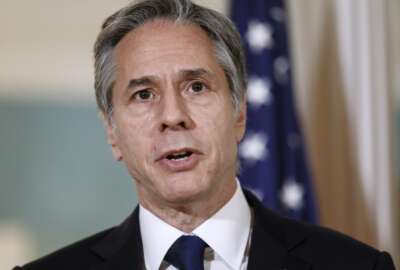Congress should invest in programs — and management
As Congress prepares to spend relatively more money than it spent on World War II, the question arises whether the federal workforce even has the capacity to ca...
Best listening experience is on Chrome, Firefox or Safari. Subscribe to Federal Drive’s daily audio interviews on Apple Podcasts or PodcastOne.
A trillion here, a trillion there — as Congress prepares to spend relatively more money than it spent on World War II, the question arises whether the federal workforce even has the capacity to carry out whatever programs the coming money will spawn. Bob Tobias said the government needs a parallel investment in management. The professor in the Key Executive Leadership Program at American University joined Federal Drive with Tom Temin for more information.
Interview transcript:
Tom Temin: Bob, I think you make a good point. The question is if there’s all these giant new probes, let alone the accountability required for that money, does the federal bureaucracy as it stands now have the capacity to deal with all of it?
Bob Tobias: Well, as you point out, Tom, we’ve got the 1.8 billion American Rescue plan, which President Biden signed on March 11. We have a 1 trillion infrastructure plan, which is up for grabs, and a 3.5 billion budget reconciliation bill that’s in the pipeline. All of this legislation creates new programs and expands existing programs. President Biden says that this is an investment in America, I think we need a parallel investment in increasing the federal manager leadership capacity to implement that congressional intention when they draft these programs.
Tom Temin: Because we’ve already seen what can happen to an agency like the IRS, which had a delayed filing season a couple of years in a row. And it also had all of these new payment mandates. And it was the agency tasked with getting those payments out, which it was able to do, but you can’t call the IRS and get anyone to answer the phone. So they had this terrible customer service failure, even though they were trying to carry out all these new mandates under strange conditions. So maybe that’s like the canary in the mineshaft.
Bob Tobias: It is. And the circus atmosphere that’s associated with the birthing of public policy. It’s conducted in this great spotlight where Rachel Maddow and Tucker Carlson have all of these conversations back and forth. And then the circus spotlight shifts to the next public policy creation issue. But what’s left are federal manager leaders who have to revise regulations for existing programs, create new regulations for new programs, designed new organizations, hire people, train people, put them into place to make the legislation reveal to the public.
Tom Temin: All right. So then do you have any sense, I mean, if they spend 5 trillion, 4.1 trillion, 3.5 trillion, there’s all these numbers that will eventually come out – who knows how much it’ll actually be? What would it take? I mean, 20% more federal workforce, 30% more? Does anyone really have that calculus available?
Bob Tobias: I don’t think so, Tom. Here’s what we know. We know that there’s a direct link between federal employee viewpoint scores and agency productivity. We also know that some federal manager leaders have natural talent, some leaders are trial and error and become great leaders. But all federal manager leaders can increase their capacity to lead others, if indeed, they’re given the training opportunity that we also know. And the real goal is for these federal manager leaders to create an environment where those they lead, choose to give their discretionary energy to the leader to accomplish these goals and objectives, to create the intellectual and the emotional connection that will lead to more productivity, and an engaged workforce.
Tom Temin: We’re speaking with Bob Tobias, professor in the key Executive Leadership Program at American University. And you also have some practical matters, though correct. To get the people ingested into the government, you have to have streamline hiring processes. But then you have to have really speedy ways of training people in for example, if someone comes in to do accountability, federal accounting is a beast all unto itself. And it has its own internal logic. But it might be very different from what you knew in the private sector. For example, if you decide, I’d like to help the government account for this money.
Bob Tobias: It’s true. When you hire new people, you have to give them skills training. And that’s often recognized, we need to give people the skills they need to perform the work. But what is often overlooked and ignored is increasing the capacity to lead increasing the ability to unlearn old ineffective behaviors and learn new effective behaviors, how to create a safe environment, how to inspire people to do the work, that focus is rarely if ever provided for so invest in these folks.
Tom Temin: Whatever happened to the, I mean, I shouldn’t say whatever happened to them, they still exist – there are training institutes for federal leadership operated by the federal government in nice settings and people can go to them. Maybe that needs to be expanded?
Bob Tobias: I think it does, Tom, I think it does. Certainly there are programs that provide, like the Key Executive Leadership program that provide leadership development opportunities, but it needs to be scaled hugely in order to meet this pressing need.
Tom Temin: Well, the question then becomes, where is the money going to come from to do this? Because what Congress is planning on appropriating may or may not have any kind of leadership development funds in it, it may have hiring funds, but that’s not the same thing that you’ve been talking about.
Bob Tobias: It is not. And I believe that agencies across the federal government have year end money, Tom. Year end money that was unspent, because there was no travel due to COVID. Everybody’s looking at their Zoom screen, they’re not getting in line and on airplanes, and traveling and hotels and spending all of the travel funds that have been allocated by Congress last year. So they have year end money to spend, invest in federal manager leaders.
Tom Temin: And there’s also the issue that a lot of the money appropriated for specific purposes. I’m thinking, for example of the Veterans Affairs Department got almost $20 billion in COVID money last year, and they only obligated about maybe a third of it, or they only spent about a third of it obligated, maybe half of it. I’m betting here and there, there are serious levels of money left over. And for purposes of training, you would think that to take a fraction of what’s left over hundreds of thousands even or a few million, that Congress might go along with reprogramming that for the purposes you outline.
Bob Tobias: Yes, indeed. The issue is, if there’s a will to invest, I believe that money is available to realize that investment. And so far, historically, leadership development has been last on the list. And I think now it needs to be first on the list.
Tom Temin: And should they start with the cabinet secretaries, these are appointees. But if they want to strengthen the departments they lead and have them somehow endure in that strength after the particular crop of politicals in there now departs, that would seem like a good investment.
Bob Tobias: It would, no question.
Tom Temin: Bob Tobias is a professor in the Key Executive Leadership Program at American University. As always, thanks so much.
Bob Tobias: Thank you, Tom. It’s a pleasure to be with you this morning.
Copyright © 2024 Federal News Network. All rights reserved. This website is not intended for users located within the European Economic Area.
Tom Temin is host of the Federal Drive and has been providing insight on federal technology and management issues for more than 30 years.
Follow @tteminWFED






